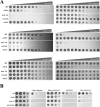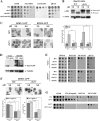Involvement of the exomer complex in the polarized transport of Ena1 required for Saccharomyces cerevisiae survival against toxic cations
- PMID: 29021337
- PMCID: PMC5706994
- DOI: 10.1091/mbc.E17-09-0549
Involvement of the exomer complex in the polarized transport of Ena1 required for Saccharomyces cerevisiae survival against toxic cations
Abstract
Exomer is an adaptor complex required for the direct transport of a selected number of cargoes from the trans-Golgi network (TGN) to the plasma membrane in Saccharomyces cerevisiae However, exomer mutants are highly sensitive to increased concentrations of alkali metal cations, a situation that remains unexplained by the lack of transport of any known cargoes. Here we identify several HAL genes that act as multicopy suppressors of this sensitivity and are connected to the reduced function of the sodium ATPase Ena1. Furthermore, we find that Ena1 is dependent on exomer function. Even though Ena1 can reach the plasma membrane independently of exomer, polarized delivery of Ena1 to the bud requires functional exomer. Moreover, exomer is required for full induction of Ena1 expression after cationic stress by facilitating the plasma membrane recruitment of the molecular machinery involved in Rim101 processing and activation of the RIM101 pathway in response to stress. Both the defective localization and the reduced levels of Ena1 contribute to the sensitivity of exomer mutants to alkali metal cations. Our work thus expands the spectrum of exomer-dependent proteins and provides a link to a more general role of exomer in TGN organization.
© 2017 Anton et al. This article is distributed by The American Society for Cell Biology under license from the author(s). Two months after publication it is available to the public under an Attribution–Noncommercial–Share Alike 3.0 Unported Creative Commons License (http://creativecommons.org/licenses/by-nc-sa/3.0).
Figures








Similar articles
-
Exomer complex regulates protein traffic at the TGN through differential interactions with cargos and clathrin adaptor complexes.FASEB J. 2021 Jun;35(6):e21615. doi: 10.1096/fj.202002610R. FASEB J. 2021. PMID: 33978245 Free PMC article.
-
Dynamic assembly of the exomer secretory vesicle cargo adaptor subunits.EMBO Rep. 2016 Feb;17(2):202-19. doi: 10.15252/embr.201540795. Epub 2016 Jan 7. EMBO Rep. 2016. PMID: 26742961 Free PMC article.
-
Exomer: A coat complex for transport of select membrane proteins from the trans-Golgi network to the plasma membrane in yeast.J Cell Biol. 2006 Sep 25;174(7):973-83. doi: 10.1083/jcb.200605106. J Cell Biol. 2006. PMID: 17000877 Free PMC article.
-
Monovalent cation transporters at the plasma membrane in yeasts.Yeast. 2019 Apr;36(4):177-193. doi: 10.1002/yea.3355. Epub 2018 Oct 3. Yeast. 2019. PMID: 30193006 Review.
-
Potassium and Sodium Transport in Yeast.Adv Exp Med Biol. 2016;892:187-228. doi: 10.1007/978-3-319-25304-6_8. Adv Exp Med Biol. 2016. PMID: 26721275 Review.
Cited by
-
Calcineurin-dependent regulation of endocytosis by a plasma membrane ubiquitin ligase adaptor, Rcr1.J Cell Biol. 2020 Aug 3;219(8):e201909158. doi: 10.1083/jcb.201909158. J Cell Biol. 2020. PMID: 32421152 Free PMC article.
-
The Functional Specialization of Exomer as a Cargo Adaptor During the Evolution of Fungi.Genetics. 2018 Apr;208(4):1483-1498. doi: 10.1534/genetics.118.300767. Epub 2018 Feb 6. Genetics. 2018. PMID: 29437703 Free PMC article.
-
Chitin Synthesis in Yeast: A Matter of Trafficking.Int J Mol Sci. 2022 Oct 14;23(20):12251. doi: 10.3390/ijms232012251. Int J Mol Sci. 2022. PMID: 36293107 Free PMC article. Review.
-
Exomer Is Part of a Hub Where Polarized Secretion and Ionic Stress Connect.Front Microbiol. 2021 Jul 19;12:708354. doi: 10.3389/fmicb.2021.708354. eCollection 2021. Front Microbiol. 2021. PMID: 34349749 Free PMC article.
-
Exomer complex regulates protein traffic at the TGN through differential interactions with cargos and clathrin adaptor complexes.FASEB J. 2021 Jun;35(6):e21615. doi: 10.1096/fj.202002610R. FASEB J. 2021. PMID: 33978245 Free PMC article.
References
MeSH terms
Substances
LinkOut - more resources
Full Text Sources
Other Literature Sources
Molecular Biology Databases
Miscellaneous

